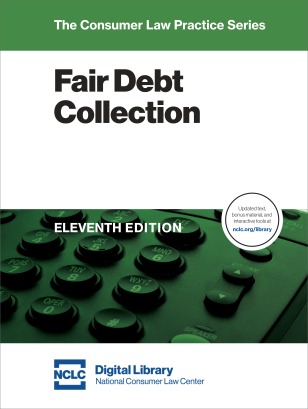The CFPB’s new Regulation F interpreting the Fair Debt Collection Practices Act (FDCPA) took effect November 30, 2021. For more detail on the new regulation see Comprehensive New FDCPA Regulation F Takes Effect November 30.
Based on a review of nearly sixty complaints alleging violations of Regulation F filed in federal court in the first six months since the effective date, this article provides initial advice for FDCPA practitioners regarding the use of Regulation F in litigation. The article lists pleading tips for Regulation F litigation, highlights particular violations of Regulation F alleged in the complaints, and links to examples of federal court complaints alleging those types of violations.
10 Pleading Tips Involving Regulation F Violations
Here are ten pleading tips for practitioners bringing FDCPA cases based on Regulation F violations.
- Cite the Specific Provision of Regulation F—When alleging a violation of Regulation F, be as precise as possible. For example, 12 C.F.R. § 1006.14(b)(2)(i)(A) is a different alleged violation than 12 C.F.R. § 1006.14(b)(2)(i)(B). Always cite to Regulation F when the regulation provides more specificity about a violation than the statute and when the complaint is relying on that specificity.
- Plead All Elements of Regulation F Violations—Regulation F has very specific requirements for violations, and a complaint should allege all elements of the Regulation F violation. Also consider the advisability of denying in the complaint the applicability of any Regulation F exceptions to the relevant provision.
- Specify Relevant Dates—Dates are important, particularly in showing that a Regulation F violation occurred after the regulation's effective date of November 30, 2021, or in proving violations of specific provisions, for example, the presumption that more than seven phone calls in a seven-day period violates 12 C.F.R. § 1006.14(b)(2)(i)(A).
- Cite to Underlying Statutory Authority—When alleging Regulation F violations, cite to both the regulation and the underlying statutory authority. For example, the statutory authority for 12 C.F.R. § 1006.14(h) is 15 U.S.C. § 1692d. This will help courts understand the basis for the Regulation F provision, which is to provide more specificity as to a specific statutory violation. To identify the statutory authority for each Regulation F provision, see the section-by-section analysis found at 85 Fed. Reg. 76,734, starting at 76,741 (Nov. 30, 2020) and 86 Fed. Reg. 5766 starting at 5771 (Jan. 19, 2021).
- Include Citations to Reg. F Restatements of FDCPA Provisions Is Optional—Many provisions of Regulation F restate the statute. For example, 12 C.F.R. § 1006.18(b)(2)(i) is a restatement of 15 U.S.C. § 1692e(2)(A). Practitioners can allege a violation of both the statute and its restatement in Regulation F by citing to both as part of the same alleged violation (for example, 15 U.S.C. § 1692e(2)(A); 12 C.F.R. § 1006.18(b)(2)(i)), but citing to specific Regulation F provisions is not required when it is merely a restatement.
- Cite to Official Interpretations Where Relevant—Cite to and, where appropriate, quote in full the relevant Regulation F Official Interpretations. The interpretations often provide helpful examples of Regulation F violations or provide key details about a Regulation F provision. For example, Official Interpretation § 42(a)(1)-1 lists relevant factors to consider to determine if a debt collector sent written or electronic disclosures “in a manner that is reasonably expected to provide actual notice.”
- Educate the Judiciary—Regulation F will be new to courts. Educate the courts by providing additional information about Regulation F generally or the particular violation alleged. For example, 12 C.F.R. § 1006.1 discusses the authority for Regulation F and its purpose. The Federal Register’s section-by-section analysis provides helpful background for the specific Regulation F provisions.
- Don’t Forget about Standing—When filing in federal court, set out in detail why there is constitutional standing. Detail the actual injury and how it was caused by the Regulation F violation. Application of constitutional standing requirements to FDCPA claims are set out in detail in NCLC’s Fair Debt Collection § 11.15. In addition, the Federal Register’s section-by-section analysis will often explain the injury that Regulation F provisions were enacted to prevent.
- Consider Filing in State Court—State court standing requirements may be more flexible than in federal court, allowing an FDCPA case to proceed in state court where may face standing challenges in federal court. For a link to a state-by-state analysis of state court standing requirements for all fifty-one jurisdictions, see NCLC’s Fair Debt Collection Appendix I.
- Establish Facts from Collector Recordings, Logs, and Records—Regulation F does not require collectors to create records or recordings, but Reg. F § 1006.100 requires debt collectors to retain for three years recordings, logs, communications, or other records. This applies to anything that is evidence of compliance or noncompliance with the FDCPA. See NCLC’s Fair Debt Collection § 11.5.4.3.
Regulation F Violations Alleged in Recent Court Filings
Regulation F defines with specificity a number of practices that violate FDCPA statutory provisions, with a focus on communications and disclosures. FDCPA complaints filed in federal court since Regulation F’s effective date have alleged violations of a variety of these specific provisions. Following a brief discussion of each of these provisions, links are provided to the full text of one or more recent complaints alleging violation of that provision. Complaints are included to illustrate the types of violations being alleged, not as model pleadings.
Limited Content Messages—Reg. F § 1006.2(j) creates a definition for a type of voicemail that debt collectors could leave for consumers. A “limited content message” that fully complies with Regulation F’s requirements is deemed not to be a “communication” and effectively provides debt collectors with a safe harbor from the requirements of 15 U.S.C. §§ 1692c(b), 1692d(6), and 1692e(11). See NCLC’s Fair Debt Collection § 4.9.
One complaint claimed that a debt collector left a message that did not qualify as a limited content message and also did not identify the caller as a debt collector in violation of 15 U.S.C. § 1692e(11) [Silva].
Electronic Communication Opt-Out Notices—Reg. F § 1006.6(e) requires debt collectors to provide a “clear and conspicuous” notice in any electronic communication to the consumer describing a “reasonable and simple” method by which the consumer can opt out of such electronic communications. See NCLC’s Fair Debt Collection § 5.9.
One complaint alleged that a debt collection email sent to the consumer did not contain the required opt-out notice [Hoskins]. Another complaint alleged that the opt-out notice was not “clear and conspicuous” [Green].
A few complaints alleged that the debt collector violated 12 C.F.R. § 1006.14(h) when it failed to stop emailing [Boykin, Demorejon, Walker] or failed to stop texting [Mellender] after the consumer opted out. Reg. F § 1006.14(h) is discussed below.
Frequent Calling—Reg. F § 1006.14(b)(2) creates a presumption of a violation where more than seven unanswered calls are made per week or where a second conversation is held within seven days—certain exceptions apply and the presumption is rebuttable. These limitations generally apply per account in collection, meaning that if a collector is collecting on three different debts, the allowed calls and conversations triple. See NCLC’s Fair Debt Collection § 6.7.
Several complaints alleged that the debt collector contacted them more than seven times in seven days in violation of 12 C.F.R. § 1006.14(b)(2)(i)(A) [for example, Marcellus, Santander, Vespo]. Some complaints alleged excessive phone calls but did not specifically plead that there were more than seven calls in a seven-day period [for example, Merrill, Sassman, Smith]. A few complaints alleged a violation even though there were not more than seven calls in seven days, based on Regulation F factors rebutting the presumption of compliance [Carlson, Cherry, Holloway].
Cases alleging frequent calls also often alleged that the debt collector failed to stop calling after being asked to do so. Some of these cases specifically alleged that failing to stop calling in response to the consumer’s request violated 12 C.F.R. § 1006.14(h) [for example, Carlson, Holloway], while others did not [for example, Merrill, Smith]. Reg. F § 1006.14(h) is discussed below.
A few complaints alleged that collectors called within seven days of a conversation with the consumer [for example, Mellender, Miterin].
Stopping Certain Types of Communications—Reg. F § 1006.14(h) requires debt collectors to stop communicating with a consumer through any communications method specified by the consumer—subject to some exceptions. This provision is not limited to consumers and also applies to third parties, such as those being contacted to obtain location information for a consumer. Unlike cease communication requests (15 U.S.C. § 1692c(c); 12 C.F.R. § 1006.6(c)), these requests can be made in writing or orally, but only apply to the specific type of communication identified, instead of stopping all communication. For example, a debt collector must stop calling a consumer who says “please stop calling”—and such requests can be made orally or in writing. See NCLC’s Fair Debt Collection § 6.9.
Numerous complaints have alleged a violation of 12 C.F.R. § 1006.14(h) [for example, Boykin, Brown, Cansler, Carlson, Cooney, Demorejon, Holloway, Mellender, Navarro, Walker]. However, as noted above, some complaints alleged facts that seemed to constitute a violation of this provision without specifically alleging a violation of this section—suggesting that violations were even more widespread.
Preconditions to Credit Reporting—Prior to Regulation F, a common collector tactic was to “park” adverse information about the debt with consumer reporting agencies (CRAs) without informing the consumer about the alleged debt. Instead, the collector waited for the consumer to discover the information on their credit report and make payments to clear it up. Reg. F § 1006.30(a) now requires collectors to take certain steps to attempt to contact the consumer before furnishing information to CRAs. See NCLC’s Fair Debt Collection § 8.12.
A few complaints alleged a violation of 12 C.F.R. § 1006.30(a) [Hill (pro se), Kempen].
Validation Notices—Reg. F § 1006.34 now has new extensive requirements for both the content and format of validation notices. See NCLC’s Fair Debt Collection Chapter 9. A number of new information requirements relate to newly defined terms like the “itemization date.” For example, the validation notice must disclose the itemization date, the amount owed on the itemization date, the name of the creditor at that date (for consumer financial product or services debts), an itemization of interest, fees, payments, and credits since the itemization date, and the current amount of the debt. See NCLC’s Fair Debt Collection §§ 9.4.2, 9.4.7.
Violations of 12 C.F.R. § 1006.34 were the most frequent Regulation F violations alleged in Regulation F complaints filed in the last six months. One or more complaints alleged that:
- The debt collector did not include the itemization date in the validation notice in violation of 12 C.F.R. § 1006.34(c)(2)(vi) [Bell, Lightfoot, Strang, Willich].
- The itemization date used was not one of the permissible dates listed in the definition of the term “itemization date” in violation of 12 C.F.R. §§ 1006.34(b)(3) and (c)(2)(vi) [Banducci, Brown, Ortiz, Rivera, Temples].
- The failure to provide the amount of the debt on the itemization date in violation of 12 C.F.R. § 1006.34(c)(2)(vii) [Willich].
- The debt collector did not provide the name of the creditor on the itemization date (for a consumer financial product or service debt) in violation of 12 C.F.R. § 1006.34(c)(2)(iii) [Lightfoot].
- The failure to provide the required itemization of interest, fees, payments, and credits since the itemization date, in violation of 12 C.F.R. § 1006.34(c)(2)(viii) [Hayden, Mills, Willich].
- The collector sent eight validation notices for different amounts that all used the same account number in violation of 12 C.F.R. § 1006.34(c)(2)(iv) [Francis].
- The collector failed to provide the name of the creditor to whom the debt currently is owed in violation of 12 C.F.R. § 1006.34(c)(2)(v) [Brown, Lightfoot].
- The debt collector incorrectly calculated the end of the validation period, shortening the length of the validation period, in violation of 12 C.F.R. §§ 1006.34(b)(5) and (c)(3) [Coleman, Morrone, Ostiguy].
- The debt collector failed to provide the date that the debt collector will consider the end of the validation period and the information about consumer protections in violation of 12 C.F.R. § 1006.34(c)(3) [Lightfoot].
- The omission of required disclosure for consumer financial product or service debt that additional information about consumer protections is on the CFPB’s website, a violation of 12 C.F.R. § 1006.34(c)(3)(iv) [Hayden].
- The failure to provide the required consumer-response information in violation of 12 C.F.R. § 1006.34(c)(4) [Lightfoot].
- The failure to provide the required validation information clearly and conspicuously in violation of 12 C.F.R. § 1006.34(d)(1) [Lightfoot].
Sending Required Disclosures—Reg. F § 1006.42 requires debt collectors sending certain disclosures, such as the validation notice, to do so “in a manner that is reasonably expected to provide actual notice” and “in a form that the consumer may keep and access later.” See NCLC’s Fair Debt Collection § 9.3.
One complaint alleged that the debt collector failed to provide the validation notice in a manner that was reasonably expected to provide actual notice in violation of 12 C.F.R. § 1006.42(a)(1) [Lightfoot].
In addition to the categories of complaints noted above, many complaints also alleged violations of Regulation F provisions that restate FDCPA provisions. These are not listed here since the focus of this analysis is on violations of specific provisions of Regulation F that provide additional interpretations of the FDCPA.



